Star Charting Apps for iPhone and iPod Touch
|
Starmap Pro
|
|
Starmap Pro
|
Starmap Pro is by far the most powerful of the star-charting apps, with a huge database of 2.5 million stars and 13,200 deep-sky objects. Though intended for serious observers using telescopes, it also has some nice features for beginners and will appeal to many armchair astronomers.
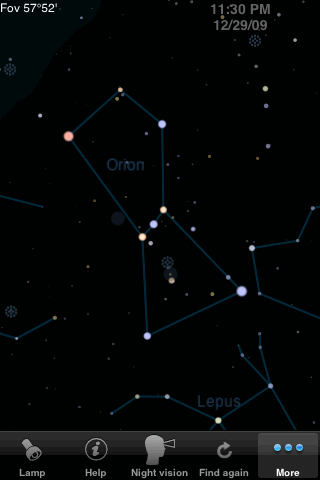 |
For an app with so many features, Starmap Pro is rather spare in the constellation department, with simple stick figures and no artist's pictures. It will show constellation boundaries, but only when you select a constellation by tapping on it. Notice the nice star colors.
Starmap Pro has seven different toolbars, which you can view all at once by tapping the More button. So the tool you want is usually two taps away. |
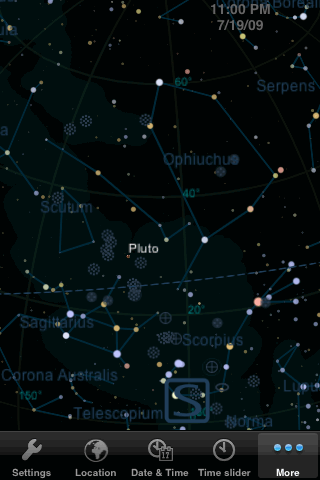 |
In Starmap Pro the maximum field is 90°. You can set the horizon to be opaque, or hide it completely, or turn on the grid and/or cardinal directions to mark it as shown here. You can also turn the ecliptic (the dashed line) on or off. |
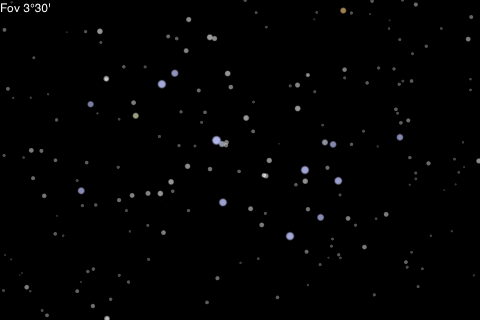 |
Zooming in reveals the enormous power of Starmap Pro, as more and more stars appear. You can resolve dozens of open clusters besides the Pleiades, and be amazed by the dense star fields of the Milky Way. There's sometimes a slight, understandable delay while zooming, as the app loads more data. The minimum field of view is about 5 arc-minutes (0.08°), much smaller than the three-degree field shown here. Note the handy (optional) field-of-view readout, which gives a measurement across the diagonal of the screen. |
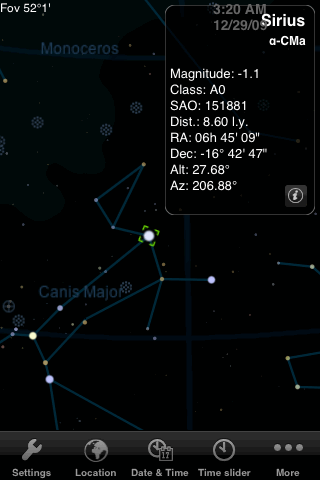  |
You can tap on any of the brighter stars (8900 of them) to get a popup showing magnitude, spectral class, and coordinates. For many stars the distance is also shown. Some of the dimmer stars are identified merely as "star", with no catalog number. Tapping the popup then takes you to a detailed emphemeris page with rise, set, and transit times, plus a graphic showing when the star is visible and a second graphic (see example below) showing altitude vs. time. (There seems to be a minor bug, however, in the time computations: notice that the transit time displayed here is several minutes later than the midpoint between the rise and set times.) |
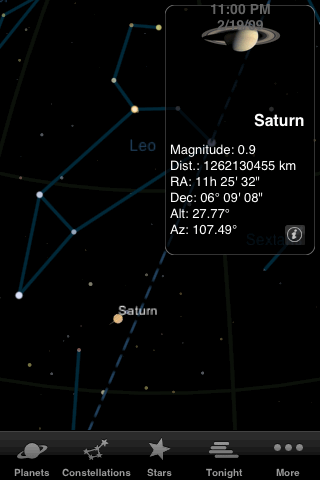 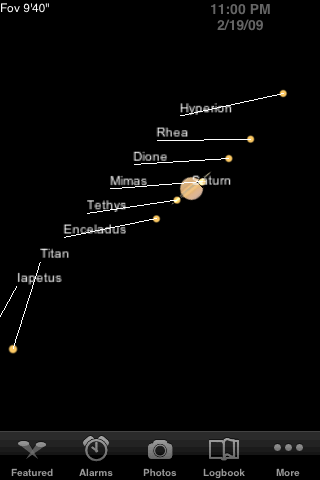 |
Starmap Pro draws planets as actual images. The popup and emphemeris pages work the same for planets as stars, but for each planet you also get a small image, and for four of the planets (Mars, Jupiter, Saturn, Uranus) the emphemeris pages show current moon locations. Starmap Pro also has the ability to zoom in directly on planets (as well as the moon). As you zoom, the planet's image first shrinks to its actual size, then grows as you zoom further. For Jupiter and Saturn you can also view the current moon locations this way. Notice that Saturn's rings are shown in their current orientation. |
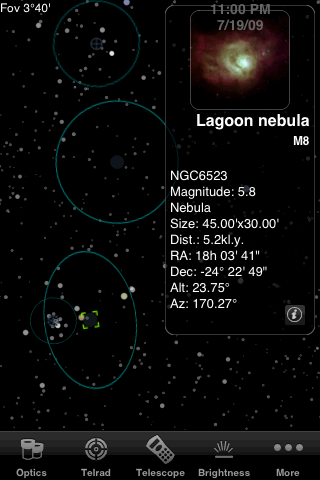 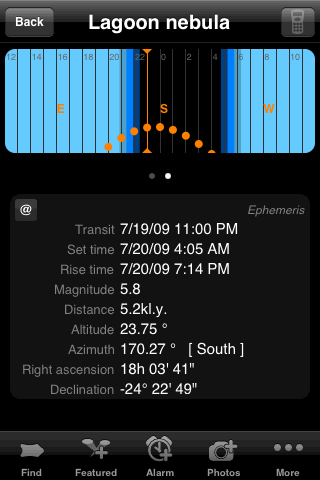 |
Starmap Pro includes the complete NGC and IC catalogs of deep-sky objects--more than 13,200 in total. The fainter ones appear as you zoom in, just as for stars. You can switch each class of objects on or off in the Settings, but you can't set a magnitude limit for DSOs. Besides the various symbols for deep-sky objects, Starmap Pro will show circles representing their approximate sizes (when this feature is enabled). You can tap on a DSO to identify it and get ephemeris information, just as for a star or planet. Starmap Pro will also show a small photo in the popup for each of the Messier objects (and for planets). |
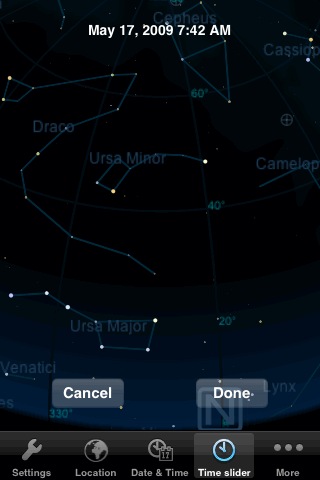 |
There are two ways to change the time in Starmap Pro. The Date & Time button lets you dial up a date and time on a separate screen. Alternatively, you can tap the Time slider button and then drag your finger horizontally to adjust the time, and/or vertically to adjust the date. But this method is convenient only for fairly small changes, and you can't otherwise animate the passage of time. Unfortunately, there is a bug in the way Starmap Pro handles daylight savings time. For example, when DST is currently in effect at your location, but you set the app to view the sky during a season when DST should not be in effect, all the times are an hour off--and turning off the DST switch throws the times off by an additional hour! |
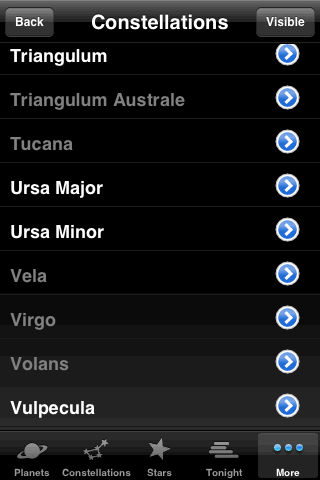 |
In Starmap Pro there are two ways to search. One is to tap a toolbar button for the desired object class (Planets, Constellations, Stars, Galaxies, Clusters, Nebulae, or Meteors), then scroll through a list to select the desired object. For the three categories of deep-sky objects, you first get a list of constellations to scroll through, then a list of objects in the selected constellation, sorted by brightness. Either way, tapping the blue arrow button takes you to the ephemeris page for the object, while tapping the object name takes you straight back to the sky chart with the object highlighted. You can also set it to guide you to the object with an arrow, starting from wherever the chart was previously pointed. Alternatively, there's a Catalogue button that lets you type in the name (or partial name) of an object, then select from a list of objects that match the entered name. This search feature is a bit slow, presumably due to the size of the catalog being searched. |
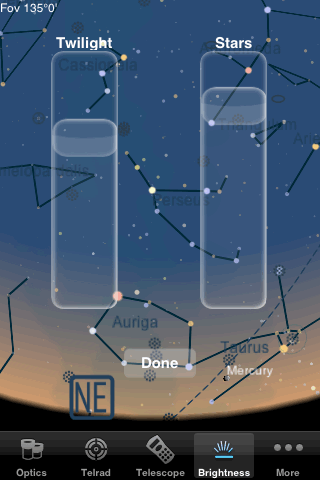 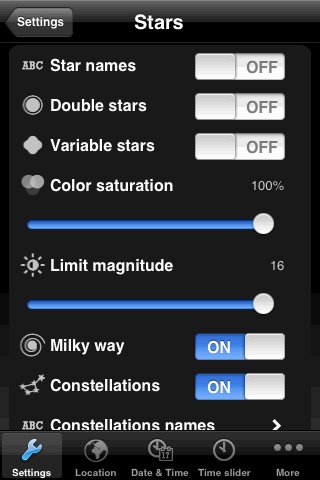 |
One of Starmap Pro's most useful toolbar buttons is the brightness control, shown at left, which has separate sliders for the sky background (black to light blue) and star image size. Separate toolbar buttons let you set the location and time. The Settings button handles almost everything else, taking you first to a menu listing Navigation, Solar System, Stars, Deep sky, and Colors. A separate page gives you access to each of these groups of settings. The color settings are a good idea but rather poorly implemented, with an incomplete range of hues and no control over saturation. It does give you separate control over the colors of most of the lines, text, and symbols that appear on the chart, but doesn't let you assign separate colors to different categories of deep-sky objects. |
Ease of Use Rating: 
The sheer number of features makes this app necessarily complex. The user interface
is straightforward but uninspired. The developer has
made a real effort to assist beginners through help screens and some other nice
features.
Information Content Rating: 
The enormous databases and detailed ephemeris information put this app in a class
by itself.
Fun Factor Rating: 
The graphics are attractive and reasonably responsive. The vast content can
entertain you for hours. But the lack of time animation and the
mediocre user interface might keep you from having too much fun.
Creator's Web Site: www.star-map.fr (Frederic Descamps)
Starmap
The regular (non-Pro) version of Starmap costs somewhat less (in the US, $11.99 vs. $18.99)
and is correspondingly less capable. I recommend either spending the extra money for the Pro
version, or considering one of the competing apps such as GoSkyWatch. Here is a quick summary
of the principal limitations of the regular version, compared to the Pro version:
Back to main page: Star Charting Apps for iPhone/iPod Touch
Last modified on 2 July 2009.
![]()
Version 1.3
Previous: iStellar
Next: Star Walk